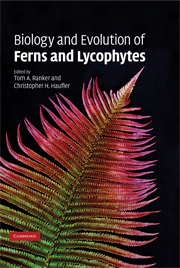Book contents
- Frontmatter
- Contents
- List of contributors
- Preface
- Acknowledgments
- Part I Development and morphogenesis
- Part II Genetics and reproduction
- Part III Ecology
- Part IV Systematics and evolutionary biology
- 12 Species and speciation
- 13 Phylogeny and evolution of ferns: a paleontological perspective
- 14 Diversity, biogeography, and floristics
- 15 Fern phylogeny
- 16 Fern classification
- Index
- References
14 - Diversity, biogeography, and floristics
Published online by Cambridge University Press: 11 August 2009
- Frontmatter
- Contents
- List of contributors
- Preface
- Acknowledgments
- Part I Development and morphogenesis
- Part II Genetics and reproduction
- Part III Ecology
- Part IV Systematics and evolutionary biology
- 12 Species and speciation
- 13 Phylogeny and evolution of ferns: a paleontological perspective
- 14 Diversity, biogeography, and floristics
- 15 Fern phylogeny
- 16 Fern classification
- Index
- References
Summary
Introduction
The biogeography of ferns and lycophytes can be studied from several points of view and with various methods. It might, for instance, examine the distribution of species on a single tree (Krömer and Kessler, 2006; Schuettpelz and Trapnell, 2006), or the frequency and abundance of species over large regions (Ruokolainen et al., 1997; Lwanga et al., 1998; Tuomisto et al., 2003; Jones et al., 2005; Tuomisto and Ruokolainen, 2005), or the relationships of species on different continents (e.g., Moran and Smith, 2001; Parris, 2001). Methods can be as varied as producing lists of plants growing on different soil types (e.g., Young and León, 1989; van der Werff, 1992), calculating the percentage of floristic similarity between different regions (Dzwonko and Kornás, 1978, 1994; Pichi Sermolli, 1979), or analyzing the phylogeny of a clade in relation to its geography and geological history (e.g., Geiger and Ranker, 2005; Hoot et al., 2006). These and other approaches have contributed to what is now an overwhelming amount of literature on the subject. To limit the subject for this chapter, three themes have been chosen: diversity, long-distance dispersal, and vicariance. After discussing these, a summary of the current state of floristics is given because biogeography is ultimately based on that subject.
Historical review
The earliest works on fern and lycophyte biogeography were mostly tabular summaries of the percentages and/or occurrences of species in different regions of the world (D'Urville, 1835; Baker, 1868; Lyell, 1879).
- Type
- Chapter
- Information
- Biology and Evolution of Ferns and Lycophytes , pp. 367 - 394Publisher: Cambridge University PressPrint publication year: 2008
References
- 68
- Cited by



